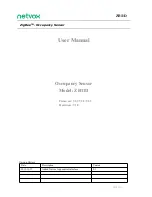
2
D. FREE FALL: Personal fall arrest systems must be rigged in such a way as to limit the free fall to a maximum
distance of six (6) feet (Ref. ANSI Z359.1-1992).
E. FALL CLEARANCE: Make certain that enough clearance exists in your fall path to prevent striking an object.
The amount of clearance needed is dependent on the subsystem in use and the anchor location.
F. CORROSION/EXPOSURE: Use near sea water or in other corrosive environments may require more frequent
inspections or servicing (replacement) to assure that corrosion or other exposure damage is not affecting
performance of the product.
G. CHEMICAL HAZARDS: Solutions containing acids, alkali, or other caustic chemicals, especially at elevated
temperatures, may cause damage to this equipment. Consult PROTECTA if doubts exist concerning installation
of equipment where chemical hazards are present.
H. ELECTRICAL HAZARDS: Do not install the AJ720A where it or the user may come into contact with electrical
power lines.
I.
TRAINING: This equipment is intended to be installed and used by persons who have been properly trained in
its correct application and use.
2.0 SYSTEM REQUIREMENTS
2.1 ANCHORAGE STRENGTH: For fall arrest applications, the anchorage point at which the AJ720A Concrete Anchor
is installed must meet minimum strength requirements. Strength requirements for fall arrest devices and systems
are outlined below.
2.2 FALL ARREST REQUIREMENTS: Anchorage devices installed for fall arrest applications must be attached to a
structural member capable of sustaining static loads in the direction(s) permitted by the PFAS when in use of at
least: (A) 3,600 lbs. (16 kN) where certification exists (reference ANSI Z359.1-1992 for certification definition), or
(B) 5,000 lbs. (22.2 kN) in the absence of certification. When more than one anchor is installed to a structure, the
strengths given in (A) or (B) above must be met at each anchor installation point independently. EXAMPLE: If two
anchors are installed on to a roof structure, each anchor must be independently capable of supporting 5,000 lbs. (or
3,600 lbs. with certification).
3.0 USE AND OPERATION
WARNINGS: Do not alter or intentionally misuse this equipment. Consult PROTECTA when using this equipment in
combination with components or subsystems other than those supplied with the product or those described in this
manual. Some subsystem and component combinations may interfere with the proper operation of this equipment. Use
caution when using this equipment around moving machinery and electrical hazards. Use caution when using this
equipment around sharp edges and chemical hazards. Consult your doctor if there is any reason to doubt your fitness to
safely absorb the shock from a fall arrest. Age and fitness seriously affect a worker’s ability to withstand falls. Pregnant
women or minors must not use PROTECTA fall protection equipment.
3.1 BEFORE INSTALLATION of this equipment, carefully inspect it to ensure that it is in serviceable condition. Check
for missing or damaged parts. D-ring, plate, and bolts should be free from corrosion. Nuts should be tightened to
required torque (see section 3.0). Refer to section 5.0 for more details. Do not use if inspection reveals an unsafe
condition.
3.2 PLAN your fall arrest or restraint system before starting your work. Take into consideration factors affecting your
safety at any time during use. The following list gives some important points you must consider when planning your
system.
3.3 ANCHORAGE: Select an anchorage point that is rigid and capable of supporting the required loads and in the
proper location.
3.4 FREE FALL: Personal fall arrest systems must be rigged to limit any free fall to a maximum of six (6) feet (OSHA
and ANSI Z359.1-1992). Restraint systems must be rigged so that NO vertical free fall is possible. Avoid working
above your anchorage level as increased free fall distance will result.
Содержание AJ720A
Страница 6: ...6 Anchor Plate Anchor Bolt 7 3 DIMENSIONS ...


























